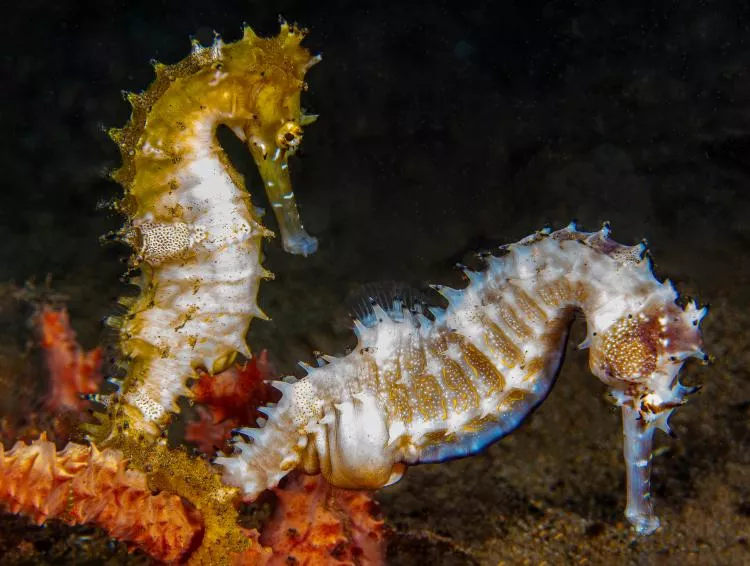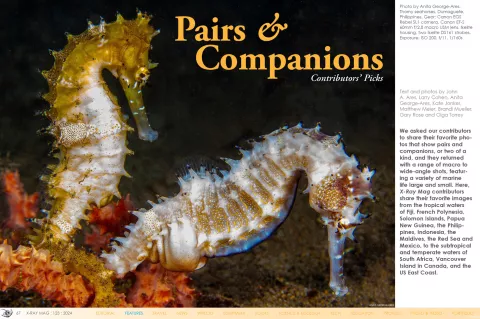We asked our contributors to share their favorite photos that show pairs and companions, or two of a kind, and they returned with a range of macro to wide-angle shots, featuring a variety of marine life large and small from around the world.
Contributed by
(To see all the images in the article, please scroll down to the end and download the PDF)
Here, X-Ray Mag contributors share their favorite images from the tropical waters of Fiji, French Polynesia, Solomon Islands, Papua New Guinea, the Philippines, Indonesia, the Maldives, the Red Sea and Mexico, to the subtropical and temperate waters of South Africa, Vancouver Island in Canada, and the US East Coast.
Two’s Company
Text and photos by Anita George-Ares, PhD
I was happy to find the pair of thorny seahorses (above) clinging to a sponge. Perhaps the female had already transferred her eggs to the male (on the right), or perhaps they were still courting.
I was also fortunate to find a Papuan cuttlefish pair displaying courtship behavior (Photo 1). The male displays raised arms above the female. I enjoyed watching the cuttlefish change body postures, colors and skin textures. The male later changed from golden to a dark red. At the same time, the female changed from a dark to a pale red with extensive white mottling.
At a shallow water dive site in the Solomon Islands, I was amazed at the extensive “meadow” of soft corals carpeting the bottom. Several orbicular batfish swam by as I photographed this pair (Photo 2).
A pair of panda butterflyfish swim in tight formation in Photo 3. Reproduction is not the only reason that butterflyfish form pairs. Same-sex pairs can also be formed to defend reef territory and food resources (Nowicki, et al. 2018). Visit: facebook.com/profile.php?id=100016947967639
Source: Nowicki, J., S.P.W. Walker, D.J. Coker, A.S. Hoey, K.J. Nicolet, and M.S. Pratchett. 2018. Pair bond endurance promotes cooperative food defense and inhibits conflict in coral reef butterflyfish. Scientific reports, article number 6295.

Large Animal Pairs
Text and photos by John A. Ares
Photographing pairs of large animals is exhilarating and is a largely regulated activity. Wherever you find them, government organizations will likely be watching you very carefully and setting limits for physical distances during encounters. Most often, encounters will be allowed if the animals approach you.
The mother humpback whale and female calf in Photo 1 were photographed in Moorea, French Polynesia. The best whale encounters almost always include a mother and calf, sometimes with an “escort” male. Photographing humpbacks are almost always regulated to surface snorkeling with no freediving. Patience and a lot of finning to get relatively close to the whales is required.
The manta rays in Photo 2 were photographed in the Maldives near a cleaning station. At cleaning stations, regulations keep divers at a distance. By keeping my head on a swivel, I was able to get this pair about five feet away, by spotting them approaching the cleaning station from behind and over my right shoulder.
The mother and nursing calf manatees in Photo 3 were photographed in very shallow water at Crystal River in Florida. Swimming with the manatees is a great experience. Photographers will be watched carefully by volunteer docents. It is best to go early and plan on being in the water near sunrise.
The pair of great white sharks in Photo 4 was photographed off Guadalupe Island in Mexico. I saw up to three great white sharks at any one time. However, earlier this year, it was reported that the Mexican government had shut down shark tourism that allowed cage diving.1 Visit: JohnAres.com
1 smithsonianmag.com
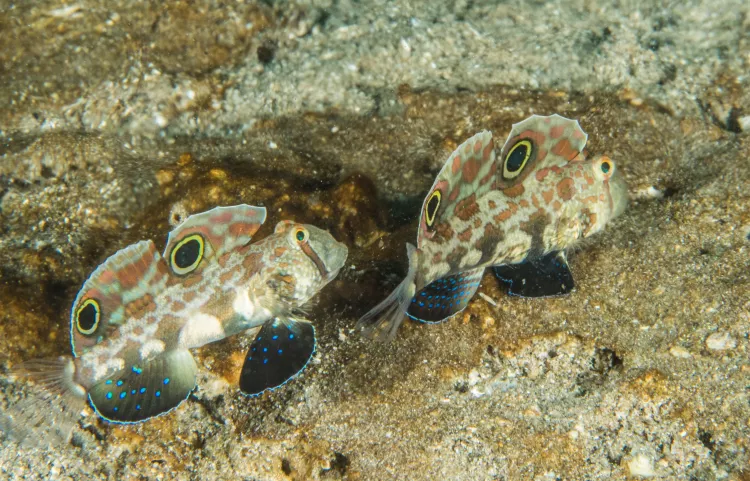
Couples
Text and photos by Larry Cohen
It is always safer and more fun to dive with a buddy. It seems like some marine species also like to travel in pairs. I spotted a pair of twin-spot gobies while diving at the Tufi House reef in Papua New Guinea (Photo 1). These tiny fish looked as if they were taking a morning walk on the sea bottom. Instead of swimming, they shuffled along the bottom and looked like they were enjoying each other’s company. These gobies have large spots on their fins. The spots fool predators into thinking they are the eyes of a large fish.
In Papua New Guinea, it is common to spot different anemonefish. At the Hanging Gardens dive site, I captured an image of a couple of false clown anemonefish (Photo 2). These fish are monogamous, but males can turn into females if no females are available. These fish live in an anemone. Mucus on their bodies prevents the fish from being stung. The anemone’s stinging tentacles, however, protect the anemonefish and their nests from predators.
At the Papua New Guinea dive site Leslie’s Knob, there was a single hawkbill sea turtle that seemed to enjoy interacting with the divers. This turtle swam in close and seemed to enjoy looking at his reflection in my dome. I used my strobes to light the turtle and the ambient light to capture a diver swimming away in the background (Photo 3). Visit: liquidimagesuw.com
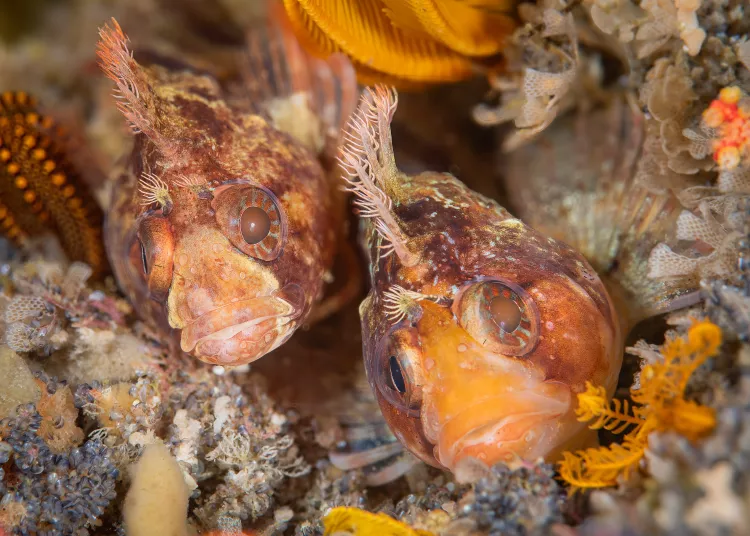
Unexpected Companionships
Text and photos by Kate Jonker
Diving deep uncovers a world teeming with unexpected companionships. On a recent dive, sheer serendipity played its part as a black nudibranch unwittingly played host to a playful amphipod, resulting in a comical snapshot of surprise (Photo 1). The encounter caught both the nudibranch and me off-guard, freezing a moment of spontaneous underwater charm.
Another peculiar duo unfolded when I zeroed in on a gasflame nudibranch (Photo 2), only to find it hitching a ride on a hermit crab. Trying to capture both pairs of “eyes” in this unusual partnership turned into a lively challenge, with the elusive crab engaging in a playful game of hide-and-seek with my lens—a comical ballet beneath the waves.
Nature’s instinctive pairings also unfold, as witnessed with the rare Chinese klipfish nestled together in the crannies of Steenbras Deep (Photo 3). The sight of these elusive creatures side by side was a thrilling rarity, their partnership creating a charming image against the backdrop of the reef.
These stories serve as a reminder that beneath the waves, life crafts its own tales of companionship, survival and even humour. Whether documenting accidental encounters or purposeful partnerships, the underwater realm is a canvas of unexpected unions waiting to be explored. So, on your next dive, keep a keen eye out for the distinctive couples that nature, in its boundless creativity, reveals beneath the surface. Visit: katejonker.com

Mated Pairs
Text and photos by Matthew Meier
For this Contributors’ Pick segment, I selected pictures of various species in mated pairs, showcasing courtship behavior. The still images do not tell the whole story of the behaviors themselves, but I tried to portray the intimacy through their proximity to one another. For instance, the whip gobies guarding their eggs (Photo 1) had obviously already mated, but they were diligently protecting and aerating their brood through frequent movement forward and back and around the whip coral strand. Capturing this image of the pair lined up in unison required patience and many failed attempts as one or both readjusted their positions often.
Similarly, the yellow pygmy gobies (in Photo 2) swam patterns around their wine-bottle home, and not always together—only staying at the opening for brief inspections of the imposing intruder at their doorstep before darting back inside. I spent half my dive attempting to time my shutter release with their swimming sequence in hopes of getting both of them in the same plane of focus.
The Coleman shrimp (Photo 3) cleared a space among the fire urchin spines and settled in as they gently swayed side to side and forth and back, in a rhythmic movement. It was quite hypnotic to watch.
Lizardfish, in my experience, are some of the more skittish creatures on the reef and usually flee from me, so it is only a guess that this is truly courtship behavior (Photo 4). I was just excited that they stayed still long enough for me to get this photo. Visit: MatthewMeierphoto.com
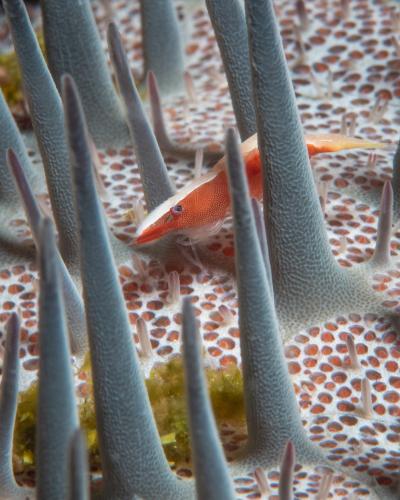
Symbiotic Companions
Text and photos by Brandi Mueller
Commensal behaviors are some of my favorite underwater pairs or companions to photograph. Living together, neither causes a problem for the other; the relationship may possibly be symbiotic, and they may actually help each other by being together.
Take, for instance, the starfish or sea star shrimp (Zenopontonia soror). These tiny shrimps are hitchhikers on the lovely sea stars. They may help the starfish by feeding on and cleaning it of parasites, although they also may eat algae or plankton drifting past in the water. In return, the shrimps get a mobile home.
They live on many types of starfish and can change their color to blend in better with their starfish. I love coming across a starfish and on closer inspection, finding one or more of these tiny shrimps camouflaged to match. Here are a few from the Red Sea and the Philippines living on starfish species, including the crown-of-thorns and blue starfish. Visit: brandiunderwater.com

Tell a Visual Story
Text and photos by Gary Rose, MD
In the past, I have written articles for this magazine regarding enhanced photographic techniques, including the use of negative space, natural lighting, silhouette, framing, shooting up, and shooting down. For this article, I am going to utilize “pairs” as a theme and will be applying, varying and adapting my technique to the ever-changing conditions of the sea, and my oceanic environment. The pairs of sharks in the photos were wonderful models and effectively helped me demonstrate how important it is for an underwater photographer to be flexible and have many techniques at his or her disposal to tell a visual story.
Photo 1 was taken in the warm, clear and tranquil waters of Tiger Beach, Grand Bahama Island. At any given time, there were 12 to 18 tiger sharks gliding by, and interestingly, these females often swam in pairs. In this photo, I added a touch of strobe lighting, directed at the snouts of this beautiful pair, to enhance the natural sunlight that bathed the reef.
Among the summer sharks at Jupiter, on the Florida coast, I always marvel at the mysterious appearance of our “ghost sharks” or sandbar sharks. They almost always first appear from the dark blue abyss as nearly invisible blue wraiths, ascending to the surface in a slow spiral. To capture this magical dance, shooting downwards, I utilized natural lighting and barely dusted this pair with my strobes to capture their mystical blue coloring (Photo 2).
Upon entry, arriving at depth, and leveling off by controlling my buoyancy, I will always rotate in a full 360° to take in my surroundings. I particularly love to shoot upwards and will take a few test shots to create the most appealing negative space (uncluttered background) to showcase my chosen subject. Then, I wait. In most cases, the photo creates itself. This pair of lemon sharks appeared, followed by a diver, and then they drifted right into my previously prepared canvas—the negative space (Photo 3).
At first glance, most viewers think that Photo 4 is a photograph of a lemon whark, with its reflection illuminated in the inky blackness of night. Then, after a few moments, the viewer invariably realizes that this is a photo of two lemon sharks passing each other at 90 degrees. I always enjoy the exclamation of surprise. This effect was created by vignette framing, that was created with the bright lighting provided by my strobes, bouncing off the reflective surface of the sharks in the center of the photo. All of the remaining light was completely absorbed by the surrounding black sea.
In addition to having technical knowledge, the underwater photographer will benefit greatly by having a broad skillset. To photograph sharks in the wild, and to capture more than the usual portrait photos, the underwater photographer should become comfortable stepping out of the box to plan, design, set up and tell a visual story. Visit: garyrosephotos.com
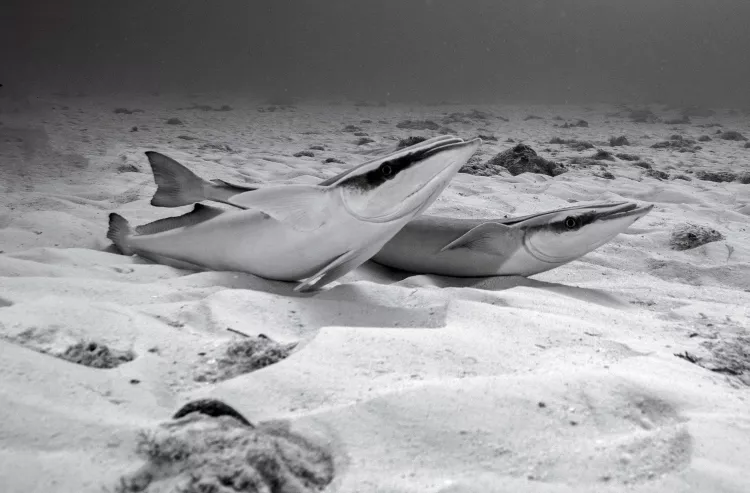
Unusual Duos
Text and photos by Olga Torrey
I went scuba diving in Cozumel, Mexico, to see the female bull sharks. Every year, female sharks return to their breeding locations in the Gulf of Mexico near Playa del Carmen. I went down with a group of divers and waited for the sharks to arrive. Then, I saw a large pair of whitefin sharksuckers swim and sit by my side on the sandy bottom, waiting for the sharks to arrive (Photo 1). The sharksuckers looked comical as they patiently waited for the sharks, so they could catch a free ride and feed on leftovers discarded by their host. Some time passed before we saw two pregnant sharks swim toward us and circle in the distance.
I traveled to British Columbia to photograph marine life I had not seen before. I went on a night dive to see the hooded nudibranchs, Melibe leonina (Photo 2). It was my first time in this area. The hooded nudibranch is a translucent sea slug which is colorless to pale yellow or green, and spends time amongst seagrass and kelp. They swim at night by bending their bodies from side to side, to propel themselves forward, forming a “C” shape. The hooded nudibranch mates during the day and feeds on planktonic invertebrates by swallowing them whole. It is born with a shell and loses it after it hatches.
If I describe an animal as an omnivore, aggressive, mean, hellish, territorial, and always in war mode with neighbors, you might think I was talking about great white or bull sharks. But I am talking about the cute and tiny two-stripe damselfish, Dascyllus reticulatus (Photo 3). This tropical fish has a laterally compressed disc-shaped body, two vertical stripes, and a blue-green tail. This animal will turn its neighborhood into an underwater war zone.
While diving in the clear, warm coastal waters on Molasses Reef in Key Largo, Florida, I noticed a pair of schoolmaster snappers slowly swimming by. I wondered why these two fish, found in large schools, were separated from the rest of the school. It seemed that these female and male schoolmaster snappers were in courtship (Photo 4). Visit: fitimage.nyc

